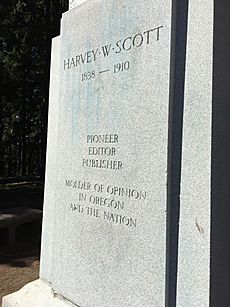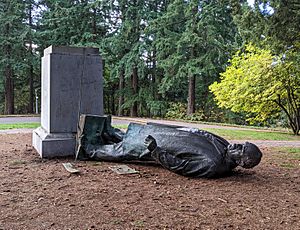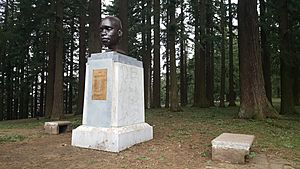Statue of Harvey W. Scott facts for kids
Quick facts for kids Statue of Harvey W. Scott |
|
|---|---|
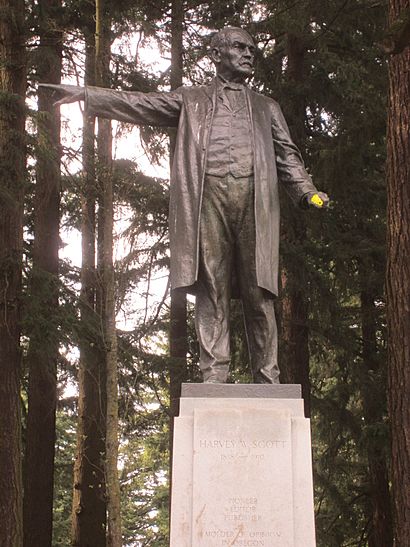
The statue in 2012
|
|
| Artist | Gutzon Borglum |
| Year | 1933 |
| Medium | Bronze sculpture |
| Subject | Harvey W. Scott |
| Dimensions | 3.4 m × 1.1 m × 1.2 m (132 in × 44 in × 47 in) |
| Weight | 2 tons |
| Condition | "Well maintained" (1993) |
| Location | Portland, Oregon, U.S. |
| 45°30′42″N 122°35′33″W / 45.51162°N 122.59240°W | |
| Owner | City of Portland and Multnomah County Public Art Collection courtesy of the Regional Arts & Culture Council |
The Statue of Harvey W. Scott was a bronze sculpture located in Portland, Oregon. It showed Harvey W. Scott (1838–1910), an important American newspaper editor and historian. The famous sculptor Gutzon Borglum created it. The statue was placed on Mount Tabor in 1933. However, it was taken down in October 2020.
This statue was one of Borglum's last works. Scott's family gave it as a gift. About 3,000 people attended the dedication ceremony. Important leaders like Governor Julius Meier and Portland mayor Joseph K. Carson were there. Scott's family also set up a fund to help maintain the statue. The City of Portland and the Regional Arts & Culture Council later managed the sculpture. Over the years, the statue was damaged several times. It was also a popular landmark in many Portland travel guides.
Contents
About the Statue
Gutzon Borglum's two-ton bronze statue showed Harvey W. Scott looking serious. Scott was a pioneer and the long-time editor of The Oregonian newspaper. The statue depicted him wearing a long coat. His right arm was stretched out, pointing west toward Downtown Portland. This symbolized looking towards the future.
The statue was located in Mount Tabor Park. This park is on Mount Tabor, which is a volcano that is not active anymore. The statue stood on the south side of the volcano's top. It faced southeast, towards Mount Scott. The large statue sat on a stone platform with benches and steps. It was about 132 inches (3.4 m) tall. Its granite base was about 102 inches (2.6 m) tall. The base had inscriptions. One side read: GUTZON – BORGLUM – SCULPTOR. The front of the base said: HARVEY W. SCOTT / 1838–1910 / PIONEER / EDITOR / PUBLISHER / MOLDER OF OPINION / IN OREGON / AND THE NATION.
Statue's Journey
The statue of Scott was one of the last artworks Borglum created. He started modeling it in his studio in 1930. At the same time, he was also working on the famous Mount Rushmore in South Dakota. The statue was finished in 1933. Scott's wife, Margaret, left money in her will after she died in 1925 to help pay for it. Other family members also contributed.
In 1928, the city council discussed accepting the statue. Several places were considered for its location. These included Mount Scott Park and Washington Park. The Oregonian newspaper reported that Borglum planned to finish the statue within a year. Once it was ready, the city council would inspect it and help choose the best spot. Scott's family members, Leslie Scott and Ambrose B. Scott, were in charge of giving the statue to Portland.
Building and Choosing the Spot
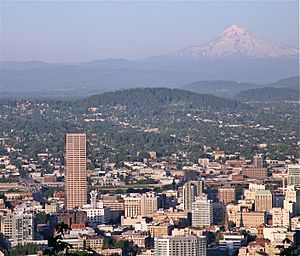
The Scott family chose Borglum to create the memorial. Borglum and the city's arts commission picked the location. Borglum visited Portland in 1928 with his son Lincoln. He thought Portland had many good spots for the statue. He chose Mount Tabor because he felt it was "... the most poetic, the most beautiful of all". During his visit, he told The Oregonian:
Our statues should be of the men who made our history. Scott, out here in Oregon, was one of them.
In May 1930, the new arts commission approved the south side of the volcano for the statue.
In October, Leslie Scott confirmed the statue would be larger than first planned. It was originally designed to be seven-foot (2.1 m). The Oregonian reported that May 1931 was the planned unveiling date. Borglum spent three months making the clay model. Then, plaster molds were made from it. These molds were sent to Chicago to be filled with bronze. Ivan Houser helped Borglum. The Kunst Foundry in New York cast the sculpture. The newspaper also described plans for the statue's base:
The pedestal of granite will be eight feet high and four feet square and will weigh 20 tons. It will have the general lines of the Doric column, expressing strength; with a slight bulge and with fluting on the corners.
The statue arrived in Portland on April 10, 1931. Work had already begun on a temporary wooden base. A few days later, the sculpture was displayed on this wooden structure at Mount Tabor's top. This allowed the arts commission to decide on the final design for the permanent granite base. In February 1932, the exact spot and direction of the statue were chosen. The arts commission, architects, and Leslie Scott spent hours testing different options. Two temporary bases were used while they made these final decisions.
Dedication and Upkeep
The statue arrived in July 1933. It was dedicated in a special ceremony attended by 3,000 people. Many important guests from out of town were there. Speakers included Governor Julius Meier and San Francisco Chronicle editor Chester Harvey Rowell. Joseph Schafer, a historian, spoke about Scott's influence on the Pacific Northwest. Leslie Scott officially presented the statue. Scott's granddaughter, Elizabeth, unveiled it. Mayor Joseph K. Carson accepted the statue for the city. Scott's family members were also there. In the 1940s, they created the Scott Statue Memorial Fund with $5,000 for future maintenance.
In 1953, the statue was temporarily stored. Its original base had a crack, so a new bronze one was installed. In 1993, the Smithsonian Institution's "Save Outdoor Sculpture!" program checked the statue. They found it was "well maintained." At that time, the City of Portland's Bureau of Parks and Recreation managed it. Later, the City of Portland and Multnomah County Public Art Collection, through the Regional Arts & Culture Council (RACC), took over. In 2010, RACC oversaw an $8,000 project to fix up the monument. Part of the money came from the Oregon Cultural Trust.
Damage and What Replaced It
The statue was damaged in May 2019 and needed cleaning. In November of the same year, someone wrote "No Thanks Land" and "Chinook Land" on it with red paint.
In October 2020, the statue was knocked down. This happened after other statues in Portland were removed during protests. Earlier that year, statues of Thomas Jefferson and George Washington were toppled. The statue of Abraham Lincoln and Theodore Roosevelt, Rough Rider were also knocked down during the Indigenous Peoples Day of Rage on October 11.
In February 2021, a bust (a sculpture of a head and shoulders) of York appeared on the empty base. The artist is unknown. York is shown as bald. A plaque says he was "The first African American to cross North America and reach the Pacific Coast." Parks commissioner Carmen Rubio said this new sculpture was important. She also said it reminds city leaders to work on including more diverse histories in public spaces. Adena Long, director of Portland Parks & Recreation, said the bureau was surprised by the new bust. As of February 20, the city planned to keep the bust on display. This is to show their commitment to a more racially inclusive history for Portland.
See also
 In Spanish: Estatua de Harvey W. Scott para niños
In Spanish: Estatua de Harvey W. Scott para niños


